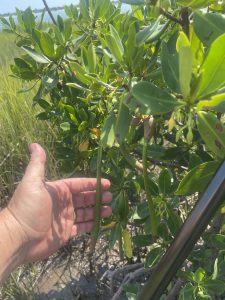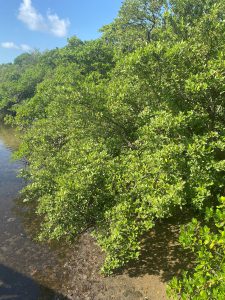When I graduated as a forester 37 years ago, the northern range of mangrove trees in coastal waters was about the Merritt Island area roughly 100 miles south of here. However, with climate change reducing the number of extreme cold events it is now possible to find black mangrove, in isolated pockets as far north as Nassau County. Even the less cold tolerant red mangrove has been reported in Duval County. With their expansion northward, perhaps it is prudent to learn a little more about these very important coastal trees.
Mangroves and coastal resiliency
In Florida mangrove trees are very important to the storm resiliency of coastal areas. They are salt tolerant and will grow along the shore holding onto sediments and stabilizing the coast protecting the shorelines, and the communities nearby from storms and hurricanes. Mangrove forests are also important as important habitat, serving as nurseries for many important commercial and sport fisheries.

Mangrove identification
There are three species of true mangroves that are found in Florida. They are the red mangrove (Rhizophora mangle), The white mangrove (Laguncularia racemose), and the black mangrove (Avicennia germinans). In Duval County the black mangrove is the most common as it is the most cold tolerant. Mangrove trees can be distinguished from many other coastal shrubs by the fact that their leaves are opposite from each other on the stem. This is called an opposite leaf arrangement.
Mangrove adaptations
Perhaps the most interesting trait among mangroves is they have different adaptations that allow them to grow in and along salt water. The red mangrove with its massive aerial roots looking as they are walking in the water can remove the salt from the salt water in the roots before it enters the plant. Often you can see salt crystals forming on the aerial roots of red mangrove for this reason. Both the white and black mangrove has glands that can excrete the excess salt. The excreted salt grains are easily visible on the of the leaves of the black mangrove. It is said that black mangrove leaves were an important source of salt for indigenous people.
Another unique adaptation of mangroves is the fact that their seeds germinate and start growing while still attached to the parent plant. This is called vivipary. The small developing plants called propagules drop from the tree and continue to develop in the water. This allows them to already be further developed once

they land on a favorable shoreline. Red mangrove propagules are long and skinny looking a lot like a red and green string bean. White mangrove propagules look very similar to sunflower seeds, while black mangrove propagules look like large lima beans. I have noticed both red and black mangrove propagules while walking on local north Florida beaches.
Mangrove protection act
While these trees are very interesting and unique, there is another reason that folks in northeast Florida need to be able to recognize mangroves growing along the shoreline. In 1996 the Florida Legislature, finding that mangroves play an important ecological role, stabilized shorelines, and contributed to local economies, passed the Mangrove Trimming and Protection Act. This legislation regulates the alteration, trimming and removal of all three mangrove species statewide. It also recognizes that property owners have a right to a “riparian view” and sets very specific rules of how they can legally be trimmed when they are growing along the shorelines. One of the most important aspects of this law is that it defines the qualifications needed to be a “Professional Mangrove Trimmer” (PMT). To find out more about the 1996 Mangrove Trimming and Protection Act go to: https://floridadep.gov/water/submerged-lands-environmental-resources-coordination/content/mangroves
While they are new to the area mangroves have always been an important part of Florida’s natural ecosystems and will increasingly be important in the northeast Florida area as they expand in our area. To find out more about mangroves go to: https://gardeningsolutions.ifas.ufl.edu/plants/trees-and-shrubs/trees/mangroves.html
 2
2
